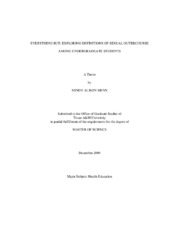| dc.description.abstract | This thesis analyzed if undergraduate students at a Southern university use the term outercourse to describe sexual behaviors that exclude penile-vaginal intercourse. A literature review revealed that no universal definition of outercourse exists and no forward progression toward a more cohesive definition was observed. Furthermore, 22 various sexual behaviors were recognized as possible outercourse behaviors. Following the literature review, a quantitative study with a minor qualitative component was conducted at a large Southern university. For this phase, 426 students responded to a 34-item online survey. After providing basic demographic information, students were asked to select the single term to describe sexual behaviors that do not include penile-vaginal intercourse. Furthermore, students were asked to determine whether or not they would classify 28 various sexual behaviors as outercourse. The respondents were provided space after each behavior to qualify or elaborate upon any uncertainty they had about the classification of a behavior. Frequencies were tabulated for the qualitative responses to each behavior. The number of comments ranged from 2 to 85 and sadomasochistic activity garnered the most comments (85). Frequency statistics were computed for all quantitative variables. Crosstabs were calculated to determine the demographic characteristics of respondents and non-respondents for each behavior.
The results revealed that a majority of the respondents were female (67.4%) and heterosexual (95.5%). Respondents preferred the term "fooling around" (63.4%) instead of outercourse (3.4%) to refer to sexual behaviors that exclude penile-vaginal intercourse. The respondents determined ten behaviors to be outercourse, five behaviors to not be outercourse, and 13 behaviors could not be classified due to the lack of a majority response. For each of the sexual behaviors, approximately 25% of the sample did not provide a response. Crosstabs revealed that freshmen students were more likely than their upperclassman counterparts to omit a response to a behavior. In contrast, juniors were most likely to respond to the sexual behavior questions.
The findings from this thesis have provided a catalyst for future interdisciplinary research endeavors and practical implications for health educators and medical professionals who work with undergraduate students. | en |


